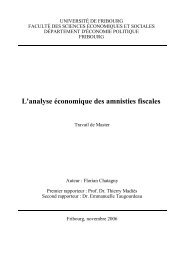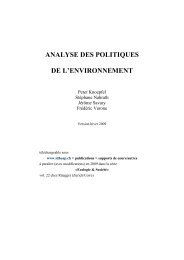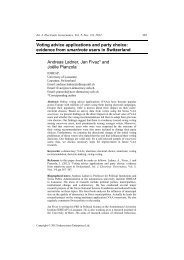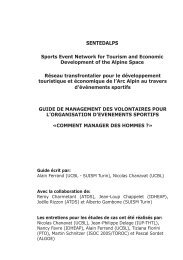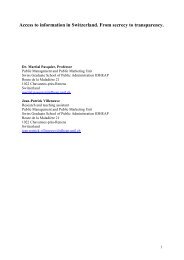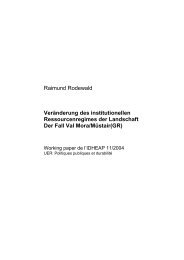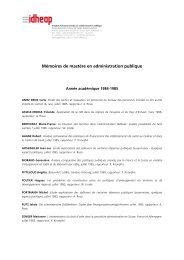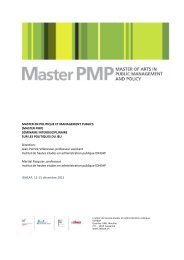Historical Analysis of Institutional Regimes in Switzerland ... - IDHEAP
Historical Analysis of Institutional Regimes in Switzerland ... - IDHEAP
Historical Analysis of Institutional Regimes in Switzerland ... - IDHEAP
You also want an ePaper? Increase the reach of your titles
YUMPU automatically turns print PDFs into web optimized ePapers that Google loves.
25<br />
support is also allocated for “measures with<strong>in</strong> a set term such as the tend<strong>in</strong>g <strong>of</strong> forests, harvest<strong>in</strong>g and<br />
haul<strong>in</strong>g, when the total costs <strong>in</strong>curred are not covered or are exceptionally high for reasons to do<br />
with the protection <strong>of</strong> nature”.<br />
Particular attention should be drawn <strong>in</strong> this context to biodiversity which was supposed to have been<br />
promoted by means <strong>of</strong> subsidies s<strong>in</strong>ce the mid-1990s. Forest protection and use policy is <strong>in</strong>terven<strong>in</strong>g<br />
<strong>in</strong> the use rights <strong>of</strong> private and public owners by compensat<strong>in</strong>g owners for not us<strong>in</strong>g forests<br />
commercially and subsidis<strong>in</strong>g ma<strong>in</strong>tenance measures. On the one hand the f<strong>in</strong>ancial support can be<br />
understood as compensation for the loss <strong>of</strong> commercial revenue while on the other, compensation<br />
payments could also be understood as the purchase <strong>of</strong> certa<strong>in</strong> elements <strong>of</strong> the environment on behalf<br />
<strong>of</strong> the Swiss people. Bromley would speak <strong>of</strong> an <strong>in</strong>stitutional change “<strong>in</strong> response to new collective<br />
perceptions <strong>of</strong> what (he) call(s) the full consumption set – for <strong>in</strong>stance, <strong>in</strong>stitutional change, that<br />
focuses on the environmental aspects <strong>of</strong> certa<strong>in</strong> commodities purchased <strong>in</strong> the market” (Bromley<br />
1997: 53).<br />
The goals <strong>of</strong> Swiss forest policy have been extended over time and multifunctionality has been<br />
stressed. Thus, the <strong>in</strong>struments for the implementation and fulfilment <strong>of</strong> the different tasks have also<br />
been adapted. Differentiation and development <strong>of</strong> the legal framework have followed the logic <strong>of</strong> the<br />
first forest law and can be described as an <strong>in</strong>cremental process. A more or less parallel development<br />
<strong>of</strong> the policy design and the regulative system can be recognised.<br />
5.3 First Comparison<br />
A comparison <strong>of</strong> the different resource regimes and their development leads to the follow<strong>in</strong>g<br />
conclusions:<br />
• Both the development and status <strong>of</strong> the resource regimes differ considerably for the five<br />
resources studied. While there was no regulation requirement for air and landscape <strong>in</strong> the last<br />
century, regimes and <strong>in</strong>centive structures were created at a very early stage for the resources<br />
water, forest and soil.<br />
• The regulative system <strong>in</strong> <strong>Switzerland</strong> was ma<strong>in</strong>ly established <strong>in</strong> the 19th century. This processes<br />
was completed with the standardisation <strong>of</strong> civil legislation at national level. The differentiation <strong>of</strong><br />
the <strong>in</strong>stitutional framework took place <strong>in</strong> the 20th century, for the most part through public<br />
policies, with little formal change to exist<strong>in</strong>g property titles. The restriction and concretisation <strong>of</strong><br />
use rights, <strong>in</strong> contrast, were implemented subsequently, ma<strong>in</strong>ly through the sectoral policies.<br />
• The trajectories are either more strongly <strong>in</strong>fluenced by order policy or sectoral policy provisions,<br />
depend<strong>in</strong>g on the beg<strong>in</strong>n<strong>in</strong>g <strong>of</strong> legislation process . It must be assumed <strong>in</strong> this context that the<br />
order policy regulation was completely acceptable up to the mid-20th century, after which state<br />
objectives were <strong>in</strong>creas<strong>in</strong>gly achieved via sectoral policy <strong>in</strong>terventions. Hence, it is possible to<br />
identify different development trajectories which were more strongly oriented towards property<br />
rights or policy design.<br />
• Sectoral policy regulations for resources differ with respect to the extent to which the <strong>in</strong>struments<br />
concern<strong>in</strong>g use rights were used. The regimes <strong>in</strong> turn differ <strong>in</strong> terms <strong>of</strong> the way <strong>in</strong> which the<br />
regulative system and sectoral policy are co-ord<strong>in</strong>ated and the sectoral policies, and hence the<br />
claims <strong>of</strong> different user groups, were co-ord<strong>in</strong>ated. Whereas for forest, there was co-ord<strong>in</strong>ation<br />
between ownership rights and sectoral policy, there is no correspond<strong>in</strong>g co-ord<strong>in</strong>ation <strong>in</strong> this<br />
form for soil.



